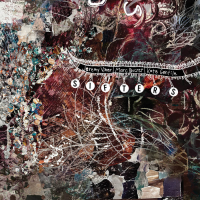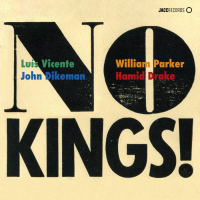Home » Jazz Articles » Extended Analysis » Stefano Bollani / Hamilton de Holanda: Stefano Bollani /...
Stefano Bollani / Hamilton de Holanda: Stefano Bollani / Hamilton de Holanda: O que sera
Bollani and de Holanda are kindred spirits; great virtuosos and prolific recording artists, both are open to experiment—whether playing solo or with orchestral accompaniment. Bollani's eclecticism is well documented, but less known—outside of Brazil—is de Holanda, who has recorded/played with multi-instrumentalist Hermeto Pascoal, harpist Edmar Castaneda, banjo player Bela Fleck and accordionist Richard Galliano. Not surpsisingly then, the music here draws equally from jazz, tango and classical music as much as it does from Brazil's rich musical heritage.
Bollani has long had a love affair with Brazilian music, having previously recorded an entire album of Antonio Carlos Jobim's music, Falando do Amor (Venus Jazz, 2003). Carioca (EmArcy, 2008), the pianist's sweeping embrace of pre-Bossa choro and samba, revealed the depth of his feeling for Brazilian music through the ages. In de Holanda, Bollani has found a simpatico musical partner. O que será sees the duo interpret the music of more mainstream Brazilian composers but in truly exhilarating, and above all, heartfelt fashion.
The duo first played together in 2009, an experience that spurred them on to tour in Europe and Brazil two years later. This recording, taken from a concert at Jazz Middelheim in 2012 finds the pair in irresistible form, and it's clear from the opening exchanges of Chico Buraque/Edu Lobo's lovely "Beatriz' that they share a deep musical empathy. Whether caressing a ballad, going hammer and tongs in breathtaking unison, or plying flowing individual yet parallel paths, there's an evident symmetry at play.
On Bollani's up-tempo "Il Barbone de Seviglia," it's difficult to tell who's leading who, though this sense of freedom provides some of the music's most exciting moments. The tremendous intuition at play in the give-and-take, the passing back and forth of the melody and the dazzling alternating solos recall the strong empathy and musical trust that Bollani shared with pianist Chick Corea on Orvieto (ECM, 2011). Neither musician holds back when it comes time to cut loose, but for the most part, whether on de Holanda's flamenco flavored "Caprichos de Espanha" or bandoneon maestro Astor Piazzolla's slow tango "Oblivión," the musicians entwine like sure-footed dancers.
A sense of fun is always bubbling away with Bollani and his well known impersonation of singer/songwriter Paulo Conte gets a run out on "Guarda Che Luna," much to the crowd's delight. Bollani's clowning offers a momentary interlude to the delightfully flowing solo and unison lines that beguile and dazzle simultaneously. The lyricism inherent to both players is best appreciated on the slower numbers; Jobim's "Luiza" is given a minimal, quite intimate reading, with Bollani's intro evoking "Honeysuckle Rose." The duo's simple, unadorned treatment of Pixinguinha's beautiful tune "Rosa" holds the elegance of yesteryear and is a fine tribute to one of Brazil's great choro legends.
Bollani and de Holanda exchange scurrying lines during Baden Powell/Vinicius de Moraes' "Canto de Ossanha," with the pianist playing bebop Tom and Jerry to the bandolim player's Django Reinhardt; it's as thrilling as it is fun. The finale comes when the two slip into a percussive duet of carnivalesque release. Dancing, classically-influenced piano signals the intro to Ernesto Nazareth's delightfully playful "Apanhei —te Cavaquinho," with Bollani and de Holanda alternating dizzyingly rapid lines. Then, tumbling in unison, with a cascade of notes flying in perfect tandem, one can almost sense the smiles on their and the audience members' faces at the sheer exhilaration and joy of the playing.
The chemistry between Bollani and de Holanda and the almost inexhaustible material at their disposal clamor for a follow-up. They could easily continue to release live albums of this caliber every couple of years, but a studio recording is also a tantalizing prospect. Perhaps the setting of four walls and minus an adoring public would induce the sort of nuance and intimacy only occasionally hinted at here. Regardless, O que será marks a high point in the discographies of both musicians.
Track Listing
Beatriz; Il Barbone di Seviglia; Caprichos de Espanha; Guarda Che Luna; Luiza; O Que Será; Rosa; Canto de Ossanha; Oblivión; Apanhei-te Cavaquinho.
Personnel
Stefano Bollani
pianoStefano Bollani: piano; Hamilton de Holanda: bandolim.
Album information
Title: Stefano Bollani / Hamilton de Holanda: O que sera | Year Released: 2013 | Record Label: ECM Records
Tags
PREVIOUS / NEXT
Support All About Jazz
 All About Jazz has been a pillar of jazz since 1995, championing it as an art form and, more importantly, supporting the musicians who make it. Our enduring commitment has made "AAJ" one of the most culturally important websites of its kind, read by hundreds of thousands of fans, musicians and industry figures every month.
All About Jazz has been a pillar of jazz since 1995, championing it as an art form and, more importantly, supporting the musicians who make it. Our enduring commitment has made "AAJ" one of the most culturally important websites of its kind, read by hundreds of thousands of fans, musicians and industry figures every month.




















